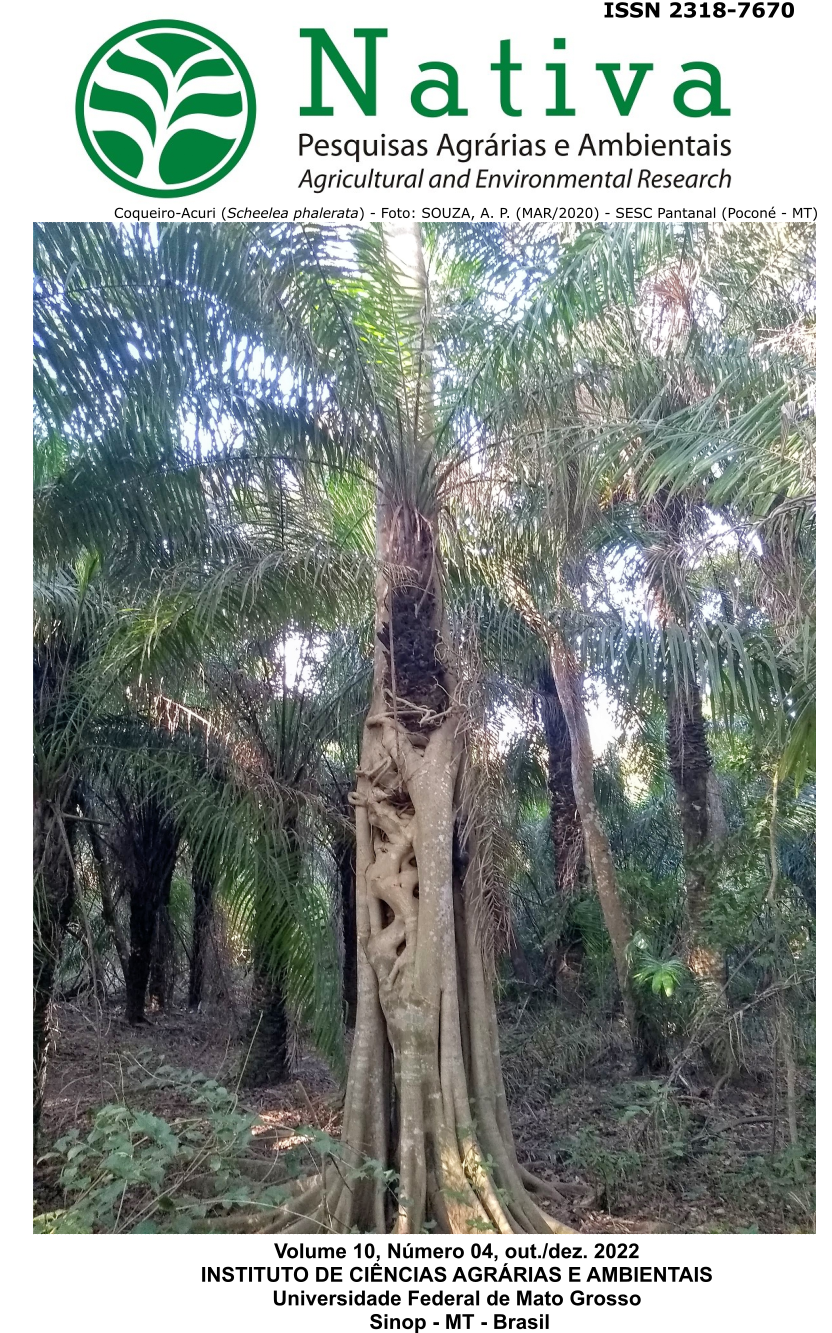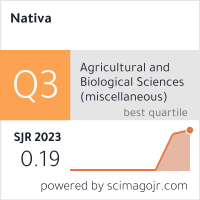COMPETIÇÃO ESPACIAL E CRESCIMENTO DE Ocotea odorifera (Vell.) Rohwer EM REMANESCENTE DE FLORESTA OMBRÓFILA MISTA
DOI:
https://doi.org/10.31413/nativa.v10i4.12086Palavras-chave:
dendrometria, dendrocronologia, índices de competiçãoResumo
O objetivo desse estudo foi avaliar o ciclo de vida e a competição de Ocotea odorifera (Vell.) Rohwer em Floresta Ombrófila Mista. Foram selecionadas árvores do sub-bosque e emergentes na Floresta Nacional de Chapecó, SC. Foram mensurados o diâmetro, projeção de copa e altura total de cada árvore amostrada. Foram obtidas amostras com trado de incremento e analisados os anéis de crescimento, para determinação do crescimento em diâmetro. Foram calculados índices de competição e ajustados modelos hipsométricos e de crescimento para cada classe de altura (< 11 m e ≥ 11 m). Os indivíduos apresentaram idade entre 47 e 220 anos, em diâmetros de 17 a 90 cm a 1,30 m de altura (DAP). A espécie é longeva, com incremento médio de 0,42 cm ano-1. O incremento médio anual difere entre classes de altura e diâmetro, sendo menor para os indivíduos que estão sob o dossel. O índice de Glover e Hool refletiu tal condição, indicando que as árvores com menor diâmetro estão sob maior pressão de competição. A análise dos índices de competição e dos modelos de crescimento permite estabelecer um prognóstico do crescimento das árvores de O. odorifera, servindo de subsídio ao planejamento do manejo para uso comercial e/ou conservação.
Palavras-chave: manejo florestal; anéis de crescimento; índice de competição.
Spatial competition and growth of Ocotea odorifera (vell.) Rohwer in a remnant of Araucaria Forest
ABSTRACT: The aim of this study was to evaluate the life cycle and competition of Ocotea odorifera (Vell.) Rohwer in Araucaria Forest. We selected understory and emerging trees from the Chapecó National Forest, Santa Catarina State. The diameter, crown projection and total heights of each sampled tree were measured. Samples were obtained with increment borer and the growth rings were analyzed to determine the growth in diameter. Competition indexes were calculated and hypsometric models and growth models were adjusted for each height class (< 11 m and ≥ 11 m). The individuals were aged between 47 and 220 years, in diameters from 17 to 90 cm at 1.30 m in height (DBH). It is a long-lived species, with an average increment of 0.42 cm year-1. The average annual increment differs between classes of height and diameter, being smaller for trees under the canopy. The Glover and Hool index reflected this condition, indicating that trees with a smaller diameter are under greater competition. The analysis of the competition indexes and the growth models allow to establish a prognosis of the growth of O. odorifera, serving as basis to the management planning for use and/or conservation.
Keywords: forest management; growth-rings; competition index.
Referências
AAKALA, T.; FRAVER, S.; D´AMATO, W. A.; PALIK, J. B. Influence of competition and age on tree growth in structurally complex old-growth forests in northern Minnesota, USA. Forest Ecology and Management, v. 308, p. 128-135, 2013. https://doi.org/10.1016/j.foreco.2013.07.057
ALVARES, C. A.; STAPE, L. J.; SENTELHAS, C. P; GONÇALVES, M. L. J.; SPAROVEK, G. Köppen’s climate classification map for Brazil. Meteorologische Zeitschrift, v. 22, n. 6, p. 711-728, 2013. 10.1127/0941-2948 / 2013/0507
ASSMANN, E. The Principles of Forest Yield Study. New York: Pergamon Press, 1970. 520p.
AZAMBUJA, W. Óleos essenciais: O início de sua história no Brasil. Disponível em: <http://oleosessenciais.org/tag/safrol/>. Acesso em: 28/02/2019.
BARBOSA, S., P. Q., CÂMARA, G. A. C.; RAMOS, S. C.; NASCIMENTO, O. C. D.; LIMA-FILHO, V. J.; GUIMARÃES, F. E. Chemical composition, circadian rhythm and antibacterial activity of essential oils of Piper divaricatum: a new source of safrole. Química Nova, v. 35, n. 9, p. 1806-1808, 2012. https://doi.org/10.1590/S0100-40422012000900019
BARREIRO, E. J.; FRAGA, C. A. M. A utilização do safrol, principal componente químico do óleo de sassafrás, na síntese de substâncias bioativas na cascata do ácido araquidônico: anti-inflamatórios, analgésicos e antitrombóticos. Química Nova, v. 22, n. 5, p. 744-759, 1999. https://doi.org/10.1590/S0100-40421999000500019
BARTOSZECK, A. C. D. P.; MACHADO, S. D. A., FIGUEIREDO FILHO, A.; OLIVEIRA, E. B. Dinâmica da relação hipsométrica em função da idade, do sítio e da densidade inicial de povoamentos de bracatinga da região metropolitana de Curitiba, PR. Árvore, v. 28, n. 4, p. 517-533, 2004. https://doi.org/10.1590/S0100-67622004000400006
BELLA, I. E. A new competition model for individual trees. Forest Science, v. 17, n. 3, p. 364-372, 1971.
BINKLEY, D.; STAPE, J. L.; RYAN, M. G.; BARNARD, H. R.; FOWNES, J. Age-related decline in forest ecosystem growth: an individual-tree, stand-structure hypothesis. Ecosystems, v. 5, n. 1, p. 58-67, 2002. https://doi.org/10.1007/s10021-001-0055-7
BIZZO, H. R.; HOVELL, A. M. C; REZENDE, C. M. Óleos essenciais no Brasil: aspectos gerais, desenvolvimento e perspectivas. Química Nova, v. 32, n. 3, p. 588-594, 2009.
BRAZ, E.M. Subsídios para o planejamento do manejo de florestas tropicais da Amazônia. 2010. 236f. Tese (Doutorado em Engenharia Florestal) – Centro de Ciências Rurais, UFSM, Santa Maria, 2010.
BRIENEN, R. J. W.; ZUIDEMA, P. A. Lifetime growth patterns and ages of Bolivian rain forest trees obtained by tree ring analysis. Journal of Ecology, v. 94, p. 481-493, 2006. https://doi.org/10.1111/j.1365-2745.2005.01080.x
BUNGARD, R. A., J. D. SCHOLES, AND M. C. PRESS. The influence of nitrogen on rain forest dipterocarp seedlings exposed to a large increase in irradiance. Plant, Cell & Environment, v. 23, n. 11, p. 1183-1194, 2000. https://doi.org/10.1046/j.1365-3040.2000.00642.x
BURKHART, H. E.; TOMÉ, M. Modeling Forest trees and stands. Springer Science & Business Media, 2012. 458p. https://doi.org/10.1007/978-90-481-3170-9
CALLEGARO, R. M.; LONGHI, S. J.; ARAUJO, A. C. B.; KANIESKI, M. R.; FLOSS, P. A.; GRACIOLI, C. R. Estrutura do componente arbóreo de uma floresta estacional decidual ripária em Jaguari, RS. Ciência Rural, v. 42, n. 2, p. 305-311, 2012.
CANETTI, A.; RUY, C. C.; MATTOS, P. P.; BRAZ, M. E. Dinâmica de crescimento de espécies de um remanescente de Floresta Ombrófila Mista em Colombo, PR. Pesquisa Florestal Brasileira, v. 34, n. 77, p. 31-37, 2014. https://doi.org/10.4336/2014.pfb.34.77.602
CANETTI, A.; MATTOS, P. P.; BRAZ, E. M.; RICKEN, P.; NETTO, S. P. Retrospective analysis of competition in a forest remnant: A case study of Podocarpus lambertii in the Araucaria Forest. Dendrochronologia, v. 40, p. 43-49, 2016. https://doi.org/10.1016/j.dendro.2016.05.003
CANSIAN, R. L.; MOSSI, A. J.; PAROUL, N; TONIAZZO, G.; ZBORALSKI, F.; PRICHOA, F. C.; LERIN, L. A. Atividade antioxidante e antimicrobiana de extratos de canela-sassafrás (Ocotea odorifera (VELL.) ROWHER). Perspectiva, v. 34, n. 127, p. 123-133, 2010.
CARVALHO, P. E. R. Espécies florestais brasileiras. Brasília: Embrapa Informação Tecnológica/Colombo: Embrapa Florestas, 2003. 1039p.
Publicado
Versões
- 2024-06-11 (2)
- 2022-11-22 (1)
Edição
Seção
Como Citar
Licença
Copyright (c) 2022 Nativa

Este trabalho está licenciado sob uma licença Creative Commons Attribution-NonCommercial 4.0 International License.
Direitos Autorais para artigos publicados nesta revista são do autor, com direitos de primeira publicação para a revista. Em virtude de a aparecerem nesta revista de acesso público, os artigos são de uso gratuito, com atribuições próprias, em aplicações educacionais e não-comerciais.
A artigos publicados nessa revista, podem ser reproduzidos parcialmente ou utilizados como referência por outros autores, desde que seja cita a fonte, ou seja, a Revista Nativa.
Copyright for articles published in this journal are the authors, with first publication rights granted to the journal. The journal shows open access, and articles are free to use, with proper attribution, in educational and non-commercial.
The articles published in this journal may be reproduced in part or used as a reference by other authors, provided that the source is quoted.






